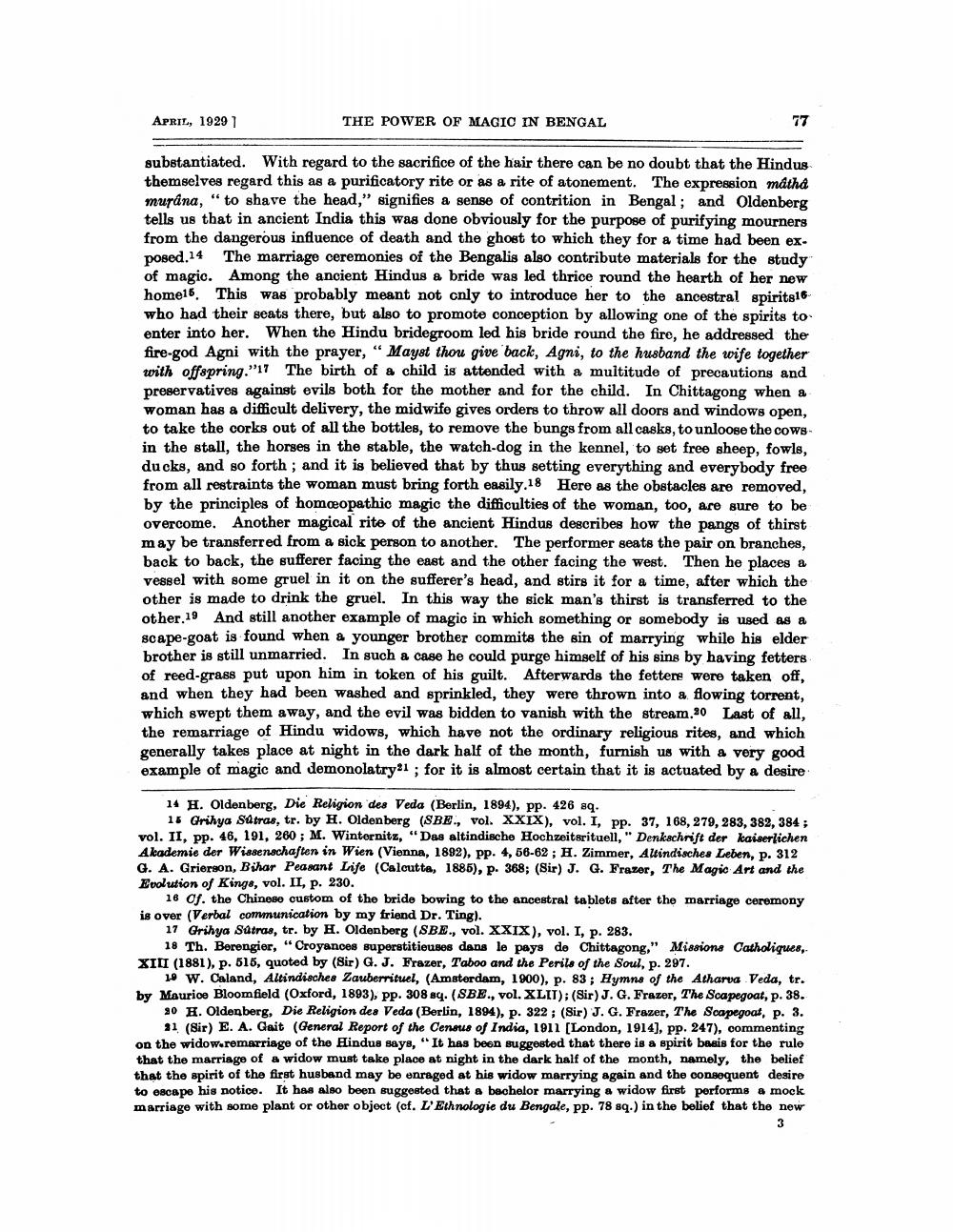________________
APRIL, 1929 1
THE POWER OF MAGIC IN BENGAL
substantiated. With regard to the sacrifice of the hair there can be no doubt that the Hindus themselves regard this as a purificatory rite or as a rite of atonement. The expression måthå murána, "to shave the head," signifies a sense of contrition in Bengal; and Oldenberg tells us that in ancient India this was done obviously for the purpose of purifying mourners from the dangerous influence of death and the ghost to which they for a time had been ex. posed.14 The marriage ceremonies of the Bengalis also contribute materials for the study of magic. Among the ancient Hindus a bride was led thrice round the hearth of her new home16. This was probably meant not cnly to introduce her to the ancestral spirits16. who had their seats there, but also to promote conception by allowing one of the spirits to enter into her. When the Hindu bridegroom led his bride round the fire, he addressed the fire-god Agni with the prayer, “Mayst thou give back, Agni, to the husband the wife together with offspring."17 The birth of a child is attended with a multitude of precautions and preservatives against evils both for the mother and for the child. In Chittagong when a woman has a difficult delivery, the midwife gives orders to throw all doors and windows open, to take the corks out of all the bottles, to remove the bungs from all casks, to unloose the cowsin the stall, the horses in the stable, the watch-dog in the kennel, to set free sheep, fowls, ducks, and so forth; and it is believed that by thus setting everything and everybody free from all restraints the woman must bring forth easily.18 Here as the obstacles are removed, by the principles of homoeopathic magic the difficulties of the woman, too, are sure to be overcome. Another magical rite of the ancient Hindus describes how the pangs of thirst may be transferred from a sick person to another. The performer seats the pair on branches, back to back, the sufferer facing the east and the other facing the west. Then he places a vessel with some gruel in it on the sufferer's head, and stirs it for a time, after which the other is made to drink the gruel. In this way the sick man's thirst is transferred to the other.19 And still another example of magic in which something or somebody is used as a scape-goat is found when a younger brother commits the sin of marrying while his elder brother is still unmarried. In such a case he could purge himself of his sins by having fetters of reed-grass put upon him in token of his guilt. Afterwards the fettere were taken off, and when they had been washed and sprinkled, they were thrown into a flowing torrent, which swept them away, and the evil was bidden to vanish with the stream.80 Last of all, the remarriage of Hindu widows, which have not the ordinary religious rites, and which generally takes place at night in the dark half of the month, furnish us with a very good example of magic and demonolatryal; for it is almost certain that it is actuated by a desire
14 H. Oldenberg, Die Religion des Veda (Berlin, 1894), pp. 426 aq.
15 Grihya Satras, tr. by H. Oldenberg (SBE., vol. XXIX), vol. I, pp. 37, 168, 279, 283, 382, 384 ; yol. II. pp. 46, 191, 260 ; M. Wintornitz, "Das altindische Hochzeitsrituell," Denkschrift der kaiserlichen Akademie der Wissenschaften in Wien (Vienna, 1892), pp. 4, 56-62; H. Zimmer, Altindisches Leben, p. 312 G. A. Grierson, Bihar Peasant Life (Calcutta, 1885), p. 368; (Sir) J. G. Frazer, The Magic Art and the Evolution of Kings, vol. II, p. 230.
16 of the Chinese custom of the bride bowing to the ancestral tablets after the marriage ceremony is over (Verbal communication by my friend Dr. Ting).
17 Grihya Sutras, tr. by H. Oldenberg (SBE., vol. XXIX), vol. I, p. 283.
18 Th. Berengier, "Croyances superstitieuses dans le pays de Chittagong," Missions Catholiques, XIII (1881), p. 515, quoted by (Sir) G. J. Frazer, Taboo and the Perils of the Soul, p. 297.
10 W. Caland, Altindisches Zauberrituel, (Amsterdam, 1900), p. 83 ; Hymns of the Atharva Veda, tr. by Maurice Bloomfield (Oxford, 1893), pp. 308 sq. (SBE., vol. XLIT): (Sir) J. G. Frazer, The Scapegoat, p. 38.
90 H. Oldenberg, Die Religion dea Veda (Berlin, 1894), p. 322 ; (Sir) J. G. Frazer, The Scapegoat, p. 3.
31 (Sir) E. A. Gait (General Report of the Census of India, 1911 [London, 1914), pp. 247), commenting on the widow.remarriage of the Hindus says, “It has been suggested that there is a spirit basis for the rule that the marriage of a widow must take place at night in the dark half of the month, namely, the belief that the spirit of the first husband may be enraged at his widow marrying again and the consequent desire to escape his notice. It has also been suggested that a bachelor marrying a widow first performs a mock marriage with some plant or other object (cf. L'Ethnologie du Bengale, pp. 78 sq.) in the belief that the new




